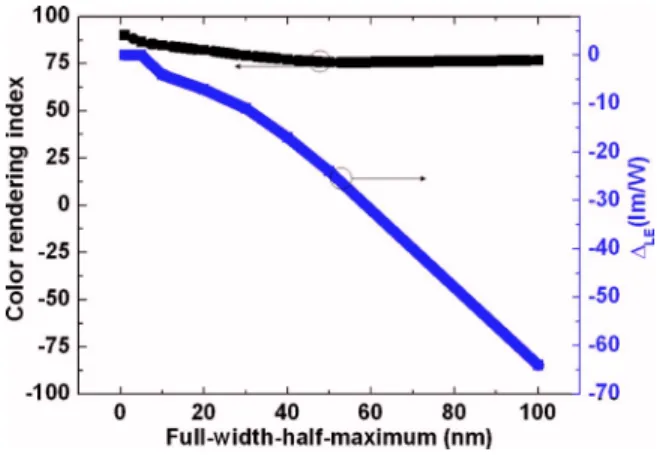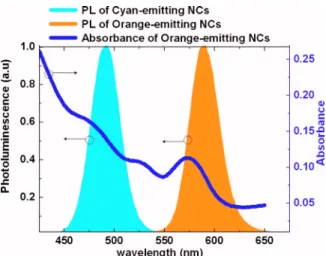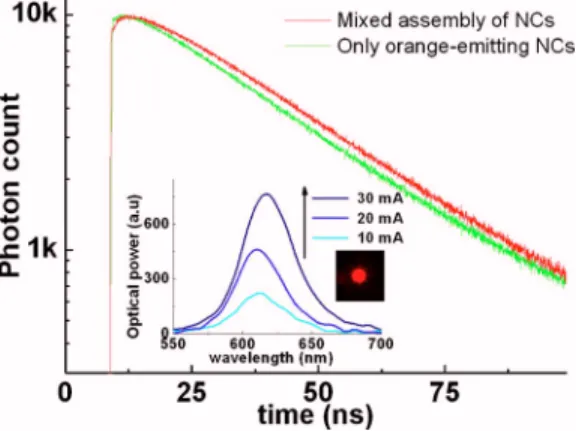Förster resonance energy transfer enhanced color-conversion using colloidal
semiconductor quantum dots for solid state lighting
Sedat Nizamoglu, and Hilmi Volkan Demir
Citation: Appl. Phys. Lett. 95, 151111 (2009); View online: https://doi.org/10.1063/1.3222902
View Table of Contents: http://aip.scitation.org/toc/apl/95/15 Published by the American Institute of Physics
Förster resonance energy transfer enhanced color-conversion
using colloidal semiconductor quantum dots for solid
state lighting
Sedat Nizamoglu and Hilmi Volkan Demira兲
Department of Electrical and Electronics Engineering, Department of Physics, and Nanotechnology Research Center, Institute of Materials Science and Nanotechnology, Bilkent University,
Ankara TR-06800, Turkey
共Received 11 June 2009; accepted 16 August 2009; published online 15 October 2009兲
In this paper, we present Förster resonance energy transfer共FRET兲-enhanced color-conversion using colloidal semiconductor quantum dot nanocrystals 共NCs兲 to make reddish-orange light-emitting diodes for use in ultraefficient solid state lighting. To achieve FRET enhancement at 614 nm, we use an energy gradient hybrid structure made of cyan- and orange-emitting CdSe/ZnS NCs 共PL= 492 and 588 nm in solution, respectively兲. This enables recycling of trapped excitons using FRET and achieves a relative quantum efficiency enhancement of 15.1% in reddish-orange full color-conversion for the integrated hybrid cyan-orange NC layer with respect to the case of full color-conversion using only orange NCs without FRET. © 2009 American Institute of Physics. 关doi:10.1063/1.3222902兴
Today lighting is one of the major energy consumption items in the world. Solid state lighting共SSL兲 potentially pro-vides substantial energy savings to allow for efficient energy utilization of the limited energy sources and reduction in carbon emission.1,2To further increase the energy saving of SSL, a photometric design 共named “ultraefficient solid-state lighting”兲 that simultaneously achieves a luminous efficacy of 408 lm/W and a color rendering index 共CRI兲 of 90 at a warm correlated color temperature of 3000 K has been proposed.3,4 To achieve these photometric properties, it is required to have a set of pure color emission in blue, green, yellow, and orange with the corresponding power levels of 1/8 at 463 nm, 2/8 at 530 nm, 2/8 at 573 nm, and 3/8 at 614 nm, each color having a full width at half maximum 共FWHM兲 of 1 nm.3,4
In this design, the reddish-orange is the strongest color component with the highest relative power 共3/8兲 and at the longest optical wavelength 共at 614 nm兲, thus with the largest number of photons emitted per unit time among the other color components.
However, the internal quantum efficiency of InxGa1−xN
structures begins to significantly drop as approaching from blue to green color in the visible due to the increased In content in multiquantum wells, though InxGa1−xN material
system has the capability to cover the whole visible. There-fore, it is not possible to obtain reddish-orange emission at 614 nm by using InxGa1−xN material system.5–7 Different
from the InxGa1−xN material system, it is possible to achieve
reddish-orange emission by using a quaternary alloy 共AlxGa1−x兲1−yInyP. However, this material system is different
from the InxGa1−xN based material system, which prevents
single-chip implementation of InxGa1−xN based red color
emission. The quantum efficiency of 共AlxGa1−x兲1−yInyP is
also observed to decrease significantly as going from red to the other colors at shorter wavelengths due to the decreasing barrier energy in their quantum well structure. As a possible solution, color-converters can be used for light generation at
614 nm on InxGa1−xN material system for reddish-orange
emission. Although phosphors are the most commonly used color converters on InGaN/GaN light-emitting diodes 共LEDs兲, they are not suitable for generating pure red/orange emission efficiently共e.g., at 614 nm of ultraefficient SSL兲, as simulated using Refs.8and9共and also shown in Fig.1兲, due
to their wide FWHM 共of about 100 nm兲, which undesirably causes the luminous efficacy to drop significantly 共down to around 64 lm/W兲. Therefore, the hybrid use of a relatively narrow color-converter is important to enable the use of InxGa1−xN LEDs at such long wavelengths.
To achieve this reddish-orange emission needed for ul-traefficient SSL, semiconductor colloidal quantum dot nano-crystals共NCs兲 exhibit favorable optical properties with their narrow and symmetric photoluminescence, which is also widely and precisely tunable across the visible using quan-tum confinement effect for the targeted peak emission wavelengths.10,11In the previous works of our group and the others, a wide range of studies on NC-integrated LEDs, Förster resonance energy transfer 共FRET兲 in NCs, and the
a兲Electronic mail: volkan@bilknet.edu.tr.
FIG. 1. 共Color online兲 Investigation of FWHM-dependent CRI and lumi-nous efficacy change in optical radiation共⌬LE兲 with respect to the case of 1
nm FWHM for ultraefficient SSL共with power levels of 1/8 at 463 nm, 2/8 at 530 nm, 2/8 at 573 nm, and 3/8 at 614 nm兲.
APPLIED PHYSICS LETTERS 95, 151111共2009兲
use of NCs in white and green/yellow LEDs have already been reported.12–17 However, FRET-enhanced color-conversion at long wavelengths critically important for ultra-efficient SSL has not been investigated to date. For that, in this paper we present NC-based orange color-conversion at long wavelengths 共614 nm兲 that utilizes FRET in full color-conversion on InxGa1−xN LEDs for enhanced efficiency. To
enable FRET in NCs, we establish an energy gradient hybrid film that embeds a custom-design assembly of cyan- and orange-emitting CdSe/ZnS core/shell NCs. By using this en-ergy gradient, the trapped excitons are recycled into NCs rather than losing them through nonradiative recombination in trap centers. As a result, we achieve a relative quantum efficiency enhancement of 15.1% in full color-conversion for this hybrid cyan-orange NC film with respect to the full color-conversion layer of only orange NCs without FRET.
Figure1 presents the CRI and luminous efficacy of op-tical radiation both decreasing as a function of increasing FWHM of 614 nm emission used in SSL as described above. Despite exhibiting FWHM linewidths larger than 1 nm共e.g., 30–40 nm兲, we find out that the resulting CRI of these NC color-converters is reduced only slightly by 11–13 units, and their luminous efficacy, only by 11–17 lm/W, compared to the case of 1 nm wide FWHM as illustrated in Fig.1. Thus, this shows that it is possible to achieve reddish-orange emis-sion at 614 nm by using NCs with sufficiently high CRI and high luminous efficacy as required for ultraefficient SSL.
To establish energy gradient, we employ cyan- and orange-emitting CdSe/ZnS core/shell NCs with photolumi-nescence peaks at 493 and 588 nm in solution, respectively, as depicted in Fig. 2. Our cyan- and orange-emitting NCs have concentrations of 171 and 70 nmol/ml in the toluene solution and molecular weights of 85 and 200 g/nmol, re-spectively. Their respective radius is around 3.2 and 4.4 nm, both with a size dispersion of⬍5%, and they exhibit a quan-tum efficiency of⬎50% in solution.18To achieve full color-conversion, we further integrate closely packed NCs in film with just sufficient amounts on the near-UV InGaN LEDs. To accomplish ultraefficient photometric properties in SSL, we reach our desired operating point around 614 nm by using the redshift of these NCs when cast into a solid film due to the resonant coupling and environmental changes. Here in operation the electroluminescence of the near-UV LED
ex-cites this integrated NC film and these NCs make photolu-minescence so that the desired reddish-orange light at around 614 nm is generated. 共The growth, fabrication, and charac-terization of these near-UV LEDs are explained in detail in Ref. 15.兲
For FRET enhancement in color-conversion using NCs, we integrate a carefully designed assembly of 5.6 nmol cyan-emitting donor NCs and 5.6 nmol orange-cyan-emitting acceptor NCs, for which the maximum quantum efficiency enhance-ment is observed at a donor-acceptor ratio of 1:1.19These are the minimum NC amounts that lead to full color-conversion in the reddish-orange, while keeping the 1:1 ratio between the cyan and orange NCs. By using this hybrid assembly of NCs, we establish a sufficient energy gradient for nonradia-tive energy transfer on the near-UV LED. This mixture of NCs further enhance the overall quantum efficiency of the integrated NC film, while fully converting the incident UV photons to reddish-orange photons 共with no UV or green photons coming off the hybrid film兲. Here the quantum effi-ciency increase comes from recycling of trapped excitonic energy in defect states of donor NCs into acceptor NCs through FRET, as also discussed in Refs. 14, 19, and 20. When the incoming near-UV light is absorbed by these NCs for color-conversion, electron-hole pairs are generated. These photogenerated electron and hole pairs then relax to their respective conduction and valence bands. Some portion of these electron-hole pairs get trapped in the defect states and typically make nonradiative recombination. This de-creases the quantum efficiency of the NC film. Using FRET, some of these trapped excitons are further transferred to the orange-emitting NCs that behave as acceptors for these de-fect states. Therefore, rather than losing the trapped excitons in defect states, a part of the transferred excitons contributes to the emission by radiative recombination.
To investigate the level of efficiency enhancement in this hybrid NC film, we also prepare a negative control group using only orange-emitting NCs. For that, we integrate 7 nmol orange-emitting CdSe/ZnS NCs on our near-UV LED, which is the minimum amount that also achieves full color-conversion in the reddish-orange color. Here for the power measurements to compare quantum efficiencies, we use an integrating sphere共Newport兲. Initially, we measure the opti-cal output power and the quantum efficiency of the near-UV LEDs; afterward, we measure those of the NC-integrated LEDs. Then, we obtain the quantum efficiency of the NC color-converters extracted from these two sets of data, sepa-rately for the cases of using hybrid NC film and control NC film. In both cases, it is made sure that it is full photon conversion to the reddish-orange for fair comparison be-tween them.
Figure3shows the time-resolved spectroscopy measure-ments of the integrated NCs at 614 nm. For time-resolved spectroscopy measurements, we use a FluoTime 200 spec-trometer 共PicoQuant兲 with a time-correlated single photon counting system of PicoHarp 300. The system has a cali-brated time resolution of 32 ps. We pump our NCs using a laser head at an emission wavelength of 375 nm with light pulses as short as 70 ps. We use a photon multiplier tube as the detector. With an output monochromator, we characterize all of the prepared NC solids at 614 nm, corresponding to the approximate peak emission wavelengths of these NC solids. In Fig. 3 the energy rising component共i.e., the exponential increase兲 in the photoluminescence kinetics of the hybrid
FIG. 2. 共Color online兲 Emission/absorption spectra of orange-emitting CdSe/ZnS core/shell NCs共acceptors兲 and emission of cyan-emitting CdSe/ ZnS core/shell NCs共donors兲.
film of these mixed cyan-orange NCs is more dominant com-pared to the case of the control NC film, because of the strong exciton migration to the orange-emitting NCs in the hybrid film. This manifests itself as a slower photolumines-cence decay at shorter times for the hybrid NC film. At longer times, the slope of the decay is almost the same for the hybrid film as that of the control film because their inter-band recombination lifetimes are similar on the order of tens of nanoseconds.21
By using the FRET-enhanced color-conversion, we ob-tain the resulting luminescence of the hybrid device chang-ing from 612 to 616 nm with the increaschang-ing current injection level as shown in the inset of Fig.3. This NC-based reddish-orange LED leads to a luminous efficacy of optical radiation at 278.7 lm/W and its energy gradient hybrid NC film achieves a quantum efficiency of 16.92% in full color-conversion of UV to reddish-orange. On the other hand, the control NC film without using FRET shows a lower quantum efficiency of 14.7%, again in the full color-conversion on the near-UV LED. As a result, the relative quantum efficiency enhancement in the hybrid cyan-orange NC film is 15.1% in full color-conversion in reddish-orange 共with respect to the only orange NCs without FRET兲. Here it is important again to note that, because of the strong nonradiative energy trans-fer, cyan-emitting NCs are fully quenched by transferring their energy to orange-emitting NCs in the hybrid film; there-fore, the hybrid film only provides orange emission. This proof-of-concept demonstration shows that NC-based LEDs enable us to reach the desired operating wavelength impor-tant for ultraefficient SSL without making major sacrifices in color rendering and luminous efficiency because of their relatively narrow emission linewidths.
In conclusion, we presented FRET-enhanced reddish-orange LEDs in which we integrated colloidal semiconductor NCs as color converters on near-UV InGaN/GaN LEDs. For that, we made a hybrid assembly of cyan- and orange-emitting CdSe/ZnS core/shell NCs to enhance the efficiency of hybrid NC LED. By recycling of the trapped excitons into NCs, we achieved a relative quantum efficiency enhance-ment of 15.1% in full color-conversion with respect to the negative control group without FRET.
We acknowledge the financial support by ESF European Young Investigator Award共EURYI兲 Program and TUBITAK under the Grant Nos. EEEAG 106E020, 107E088, 107E297, 109E002, and 109E004. H.V.D. acknowledges additional support from the Turkish National Academy of Sciences Dis-tinguished Young Scientist Award 共TUBA GEBIP兲.
1The Promise of Solid State Lighting for General Illumination Light
Emit-ting Diodes共LEDs兲 and Organic Light Emitting Diodes 共OLEDs兲, Opto-electronics Industry Development Association, Washington, DC 共http:// www.netl.doe.gov/ssl/PDFs/oida_led-oled_rpt.pdf兲.
2Solid State Lighting, Sandia National Laboratories 共http:// lighting.sandia.gov兲.
3J. M. Phillips, M. Coltrin, M. Craford, A. Fischer, M. Krames, R.
Mueller-Mach, G. Mueller, Y. Ohno, L. Rohwer, J. Simmons, and J. Tsao,Laser Photonics Rev. 1, 307共2007兲.
4J. Y. Tsao, Proceedings of the 21st Annual Meeting of The IEEE Lasers & Electro-Optics Society Conference共IEEE/LEOS, USA, 2008兲, WU4. 5I. K. Park, M. K. Kwon, J. O. Kim, S. B. Seo, J. Y. Kim, J. H. Lim, S. J.
Park, and Y. S. Kim,Appl. Phys. Lett. 91, 133105共2007兲.
6Y. H. Cho, Y. H. Cho, S. K. Lee, H. S. Kwack, J. Y. Kim, K. S. Lim, H.
M. Kim, T. W. Kang, S. N. Lee, M. S. Seon, O. H. Nam, and Y. J. Park, Appl. Phys. Lett. 83, 2578共2003兲.
7C. Bayram, F. Hosseini Teherani, D. J. Rogers, and M. Razeghi, Appl. Phys. Lett. 93, 081111共2008兲.
8E. F. Schubert, Light Emitting Diodes共Cambridge University Press, New
York, 2006兲.
9CIE 013.3-1995.
10A. P. Alivisatos,Science 271, 933共1996兲.
11S. Gaponenko, Optical Properties of Semiconductor Nanocrystals
共Cam-bridge University Press, New York, 1998兲.
12S. Nizamoglu, G. Zengin, and H. V. Demir,Appl. Phys. Lett. 92, 031102
共2008兲.
13U. Banin,Nat. Photonics 2, 209共2008兲.
14S. Nizamoglu and H. V. Demir,Opt. Express 16, 13961共2008兲. 15S. Nizamoglu, T. Ozel, E. Sari, and H. V. Demir, Nanotechnology 18,
065709共2007兲.
16C. R. Kagan, C. B. Murray, M. Nirmal, and M. G. Bawendi,Phys. Rev. Lett. 76, 1517共1996兲.
17S. Nizamoglu, E. Sari, J.-H. Baek, I.-H. Lee, and H. V. Demir,IEEE J. Sel. Top. Quantum Electron. 15, 1163共2009兲.
18Evident Technologies 共http://www.evidenttech.com/products/evidots/ evidot-specifications.html?searched⫽shelf⫹lifetime&highlight
⫽ajaxSearch_highlight⫹ajaxSearch_highlight1⫹ajaxSearch_highlight2兲.
19S. Nizamoglu, O. Akin, and H. V. Demir,Appl. Phys. Lett. 94, 243107
共2009兲.
20T. A. Klar, T. Franzl, A. L. Rogach, and J. Feldmann,Adv. Mater. 17, 769
共2005兲.
21M. Achermann, M. A. Petruska, S. Kos, D. L. Smith, D. D. Koleske, and
V. I. Klimov,Nature共London兲 429, 642共2004兲.
FIG. 3. 共Color online兲 Time-resolved spectroscopy measurements of the integrated orange-emitting CdSe/ZnS core/shell NCs 共PL= 588 nm兲 and
hybrid cyan- and orange-emitting CdSe/ZnS core/shell NCs共PL= 492 and
588 nm, respectively兲 on near-UV LED 共EL= 379 nm兲 along with the emis-sion spectra at different levels of current injection at room temperature and picture of the hybrid NC-LED when electrically driven.


